We were near the middle of our 9-day vacation when, after spending several days in the Keokuk, Iowa area collecting geodes, we headed south to Oklahoma. Our plan was to collect mineralized fossil wood with our Okie friend, Virgil Richards. After a day long drive on Tuesday, April 3rd, we set up camp at a KOA in the Tulsa burbs. We joined Virgil and Regina for a nice meal at the nearby Cherokee Casino.
On Wednesday, we drove about 60 miles to a location in the northeast Oklahoma hill country that is known to contain mineralized fossil wood, chalcocite, carnotite, azurite, malachite and barite. As background, we had been to this location with
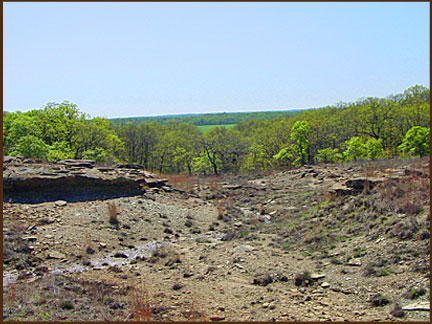 Virgil in April 2006. Although we had only planned to surface collect that day, I located what appeared to be a buried section of mineralized wood. I only had a small scratching tool with me at the time and was only able do some minor digging, but managed to recover some decent material. However, it was my belief at the time that the section of log may have continued in the subsurface so that and more and, perhaps, better material could be recovered with more time and the proper tools. I assumed that Virgil would head back out there sometime with better tools to continue digging where I had left off, but he stayed his usual busy with other things and never got around to it. So, there we were together again hoping that I had been right.
Virgil in April 2006. Although we had only planned to surface collect that day, I located what appeared to be a buried section of mineralized wood. I only had a small scratching tool with me at the time and was only able do some minor digging, but managed to recover some decent material. However, it was my belief at the time that the section of log may have continued in the subsurface so that and more and, perhaps, better material could be recovered with more time and the proper tools. I assumed that Virgil would head back out there sometime with better tools to continue digging where I had left off, but he stayed his usual busy with other things and never got around to it. So, there we were together again hoping that I had been right.
We parked on a remote dusty road and hiked about 1/2-mile through some thick brush to the collecting area. Just about the time that we arrived and started to look around, we heard what sounded like a loudly blaring police car siren that seemed to be coming from the direction of where we had parked. We all looked at each other puzzled and worried, wondering what a cop was doing out so far from civilization and if he was trying to get our attention. Virgil and I hurried back out to the road to see what was up, but there was no cop car to be seen. However, driving out through a gate from the other side of the road was a beat up old truck with a large siren mounted above the cab. Driving the truck was 60-ish age woman. She seemed to be as puzzled to see us and we were to see her when she got out of her truck. We told her that we had heard her siren and wondered what was going on. She told us that she has used a siren for many years to attract her free-range cattle to the hay and other feed that she leaves for them. "It is about the only way I know to get their attention when they are out in the brush", she said. Virgil told her that her system works good on humans too. We exchanged a few pleasantries, telling the very friendly woman what we were doing that day, and made our way back to the collecting area. Chrissy was relieved and amused to hear what happened.
While Chrissy surface collected with Opal, Virgil and I turned our attention to the mineralized wood spot from the previous year. Nothing whatsoever had changed and it appeared that nobody else had ventured out to the remote location. We went about carefully removing the relatively soft overburden and, within about 20 minutes, I started pulling out nice pieces of black, green
and blue colored mineralized wood. Lucky for us, the log section continued in the direction that I had in envisioned.
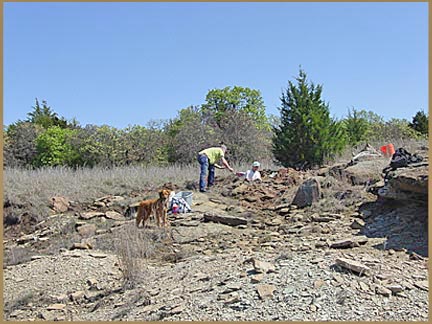
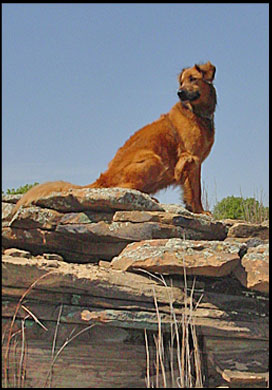
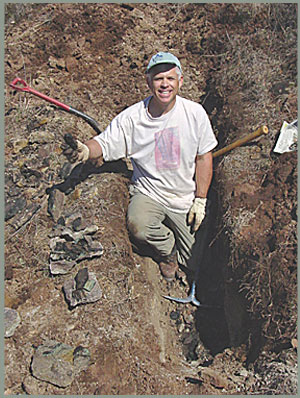
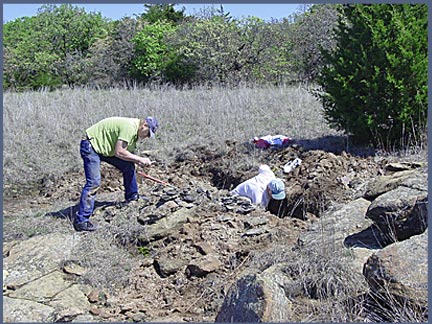
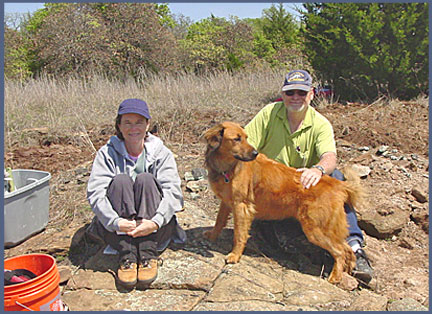 We followed the buried wood at a depth of 3-4 feet for about 8 linear feet and decided to quit and fill in our hole when we reached a very hard sandstone outcrop. By then, we had recovered a whole bunch of excellent material and were not willing to undermine or attack the sandstone. Chrissy and Virgil are always happy to demonstrate that it is whole lot easier to sit on a rock than bust it!
We followed the buried wood at a depth of 3-4 feet for about 8 linear feet and decided to quit and fill in our hole when we reached a very hard sandstone outcrop. By then, we had recovered a whole bunch of excellent material and were not willing to undermine or attack the sandstone. Chrissy and Virgil are always happy to demonstrate that it is whole lot easier to sit on a rock than bust it!
It wasn't until we got home and I had a chance to wash off and inspect the mineralized wood specimens that I realized how special they actually are. Rather than typical silicified or carbonized wood, this material has been replaced mostly with chalcocite while some of the smaller pieces appear to be replaced with malachite and/or azurite, although the latter minerals are mostly a surface coating. Since most of the surfaces are green with some blue, I had originally thought that the wood had been predominately replaced with malachite and azurite, but I polished several of the ends and discovered the material to be shiny black and submetallic and, therefore, most likely chalcosite. There is also massive orange-colored barite incorporated within the mineralized wood layers in addition to an tiny acicular form in small patches on a few specimens. This material is indeed special and way cool!
The following pictures show some of what we recovered that day.
Click on each specimen picture to enlarge
Click on each specimen picture to enlarge